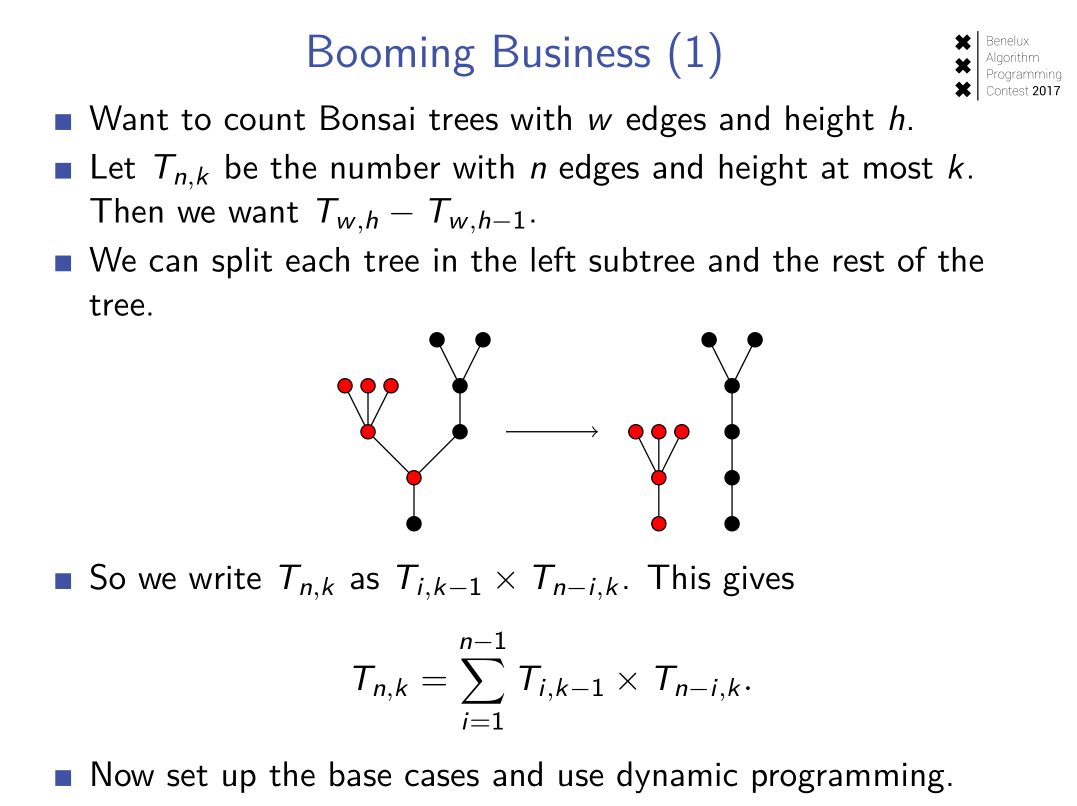题目描述
You are an expert in bonsai, the Japanese art of cultivating small trees in small containers.Every year, you win the Bonsai Association’s Pruning Competition (BAPC). With all this talent, it would be a shame not to turn your hobby into your job. Recently, you have rented a small store where you will sell your creations. Now you need to make a window display to draw in customers. Of course, you would like to grow the most impressive tree that will fit the window, but the window is only so tall, and the floor of the display can only bear so much weight. Therefore, you want a tree that is exactly so tall and so heavy that it can fit in your window.
Being an expert, you know that by definition a bonsai tree consists of a single branch, with 0 or more smaller bonsai trees branching off from that branch.

To make the most use of your window, you want to produce a bonsai tree of the precise height and weight that it can support. To get an idea of the number of options available to you, you would like to know how many different trees you could possibly grow for your store. Given a height and a weight, can you determine the number of trees with exactly that height and weight? Because the number may be very large, you may give your answer modulo 1,000,000,007.
Being an expert, you know that by definition a bonsai tree consists of a single branch, with 0 or more smaller bonsai trees branching off from that branch.

figure 1: Four distinct examples of bonsai trees.
The height and weight of a bonsai tree can be carefully determined. A tree’s weight is equal to the number of branches that appear in it. The weights of the trees in figure 1 are 1, 4,6 and 6, respectively. A tree’s height is equal to the length of the longest chain of branches from the root to the top of the tree. The heights of the trees in figure 1 are 1, 2, 3 and 3,respectively.To make the most use of your window, you want to produce a bonsai tree of the precise height and weight that it can support. To get an idea of the number of options available to you, you would like to know how many different trees you could possibly grow for your store. Given a height and a weight, can you determine the number of trees with exactly that height and weight? Because the number may be very large, you may give your answer modulo 1,000,000,007.
输入
A single line containing two integers, h and w, with 1 ≤ h, w ≤ 300.
输出
Output a single line containing a single integer, the number of bonsai trees of height h and weight w, modulo 109+7.
样例输入
2 4
样例输出
1
思路:状态dp[h][w]表示高度限制为h的情况重量等于w的树的种数(也就是高度不超过h的重量为w的种数),则状态转移方程为dp[h][w]=sum{i=1~w-1 dp[h-1][i]*dp[h][w-i]};
最终答案是dp[h][w]-dp[h-1][w];
(为什么是这样的呢?↓↓

)
AC代码:
#include <iostream> #include<cstdio> #define mod 1000000007 typedef long long ll; using namespace std; ll dp[310][310]; int main() { int h,w;scanf("%d%d",&h,&w); for(int i=1;i<=h;i++) dp[i][1]=1; for(int i=1;i<=h;i++){ for(int j=1;j<=w;j++){ for(int k=1;k<=j-1;k++){ dp[i][j]=(dp[i][j]+dp[i-1][k]*dp[i][j-k]%mod)%mod; } } } ll ans=((dp[h][w]-dp[h-1][w])%mod+mod)%mod; printf("%lld ",ans); return 0; }
太巧妙了tql